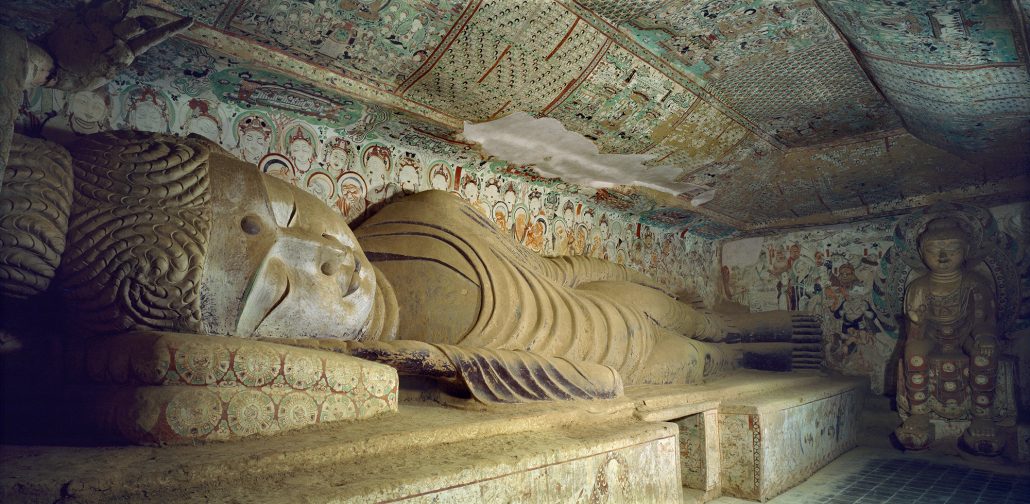
Theravada Buddhism (Hinayana Buddhism)
Hinayana Buddhism spread first in India where it disappeared later completely, forced back by Islam invaders and by Hinduism. Today the early form of Buddhism is still practiced as Theravada Buddhism in Sri Lanka and Southeast Asia (Laos, Cambodia, Myanmar, Thailand, Vietnam).
Theravada (Pali: thera “elders” + vada “word, doctrine”), the “Doctrine of the Elders,” is the name for the school of Buddhism that draws its scriptural inspiration from the Pali Canon, or Tipitaka, which scholars generally accept as the oldest record of the Buddha’s teachings. For many centuries, Theravada has been the predominant religion of Sri Lanka, Burma, and Thailand; today Theravada Buddhists number over 100 million world-wide.
The term “hinayana” is a Mahayana polemical term coined by later Indian Buddhists (see Mahayana Buddhism) to both classify and refer to those schools of Buddhism with which the Mahayana disagreed. No school of Buddhism actually referred to itself as hinayana, “the scorned vehicle.” Later the term hinayana took on differing meaning referring to a type of lesser attitude.
As for the Mainstream schools of India – that is, all the schools of Buddhism of India that were not Mahayana (which was a very small minority movement within India), all died out except the Theravada because the Theravada was ensconced in Sri Lanka, away from the Hindu persecutions and Muslim invasions.
Mahayana Buddhism
By its very nature Hinayana was more a philosophy than a religion. The individual was fully responsible for his own destiny. The whole concept is rather abstract.
The strong emphasis of meditation to achieve enlightenment (Nirvana) may have been appropriate for a monk. But imagine this for a common man, a farmer who had to work hard in his fields from dusk to dawn! The intellectual nature of the early form of Buddhism made it inapt as a mass movement.
Mahayana Buddhism spread mainly to the North, to Nepal, China, Mongolia and Japan. The development of Mahayana began about 100 AC. The term Mahayana means “large vehicle”. It was meant to indicate that it was apt for many, whereas Hinayana (“small vehicle”) was only good for a few. Originally the word Hinayana was meant a bit derogatory.
Vajrayana Buddhism
It took two attempts to bring Buddhism to Tibet. The first one took place under King Songtsen Ganpo (ruled 630-649 AC) when he married a Nepalese and a Chinese princess. Both were active Buddhists and brought their religion to Tibet.
The result was Tibetan Buddhism or Vajrayana (“diamond vehicle”) or Tantric Buddhism or Lamaism. These are all terms for more or less the same kind of Buddhism, a further development of Mahayana to this unique form of colorful and hard to understand religious culture of Buddhas, deities, saints, sages, gurus and sometimes historic figures mixed with mythological tales.
Another strong aspect of Tibetan Buddhism is clericalism. In no other country the monasteries gained as much influence as in Tibet. Before the occupation of Tibet by the Chinese communists, an estimated 20% of the population may have lived as monks and nuns in cloisters.
Of course, Vajrajana is more than just the aspects of early Buddhism plus shamanistic plus clerical elements. But this is the mix that produced Tibetan culture as we have learned it today from the Tibetan refugees and their charismatic leader, the 14th Dalai Lama.
Zen Buddhism
At the heart of the Japanese culture lies Zen, a school of Mahayana Buddhism. Zen is, first and foremost, a practice that was uninterruptedly transmitted from master to disciple.
In the Soto school of Zen, Zazen, or sitting meditation, is the core of the practice. After all, Zazen was the vehicle of Buddha‘s Awakening. Shikantaza or “just sitting” is the essence of Soto Zen. There is no goal to be attained beyond the practice itself.
Soto Zen practitioners do not actively seek Enlightenment or Satori (the Zen Buddhism term for enlightenment), but rather they seek to fully experience every moment; that is, to be acutely aware of every action in the here and now.
While the heart of the Soto school is based on the practice of Zazen, the heart of the Rinzai school focusses on the use of koan, a kind of phrase or statement which is given by a teacher to a disciple to trigger Enlightenment.
Zen teachers often recite and comment on koans, and some Zen practitioners concentrate on koans during Zazen meditation.
Western Buddhism
The flight of the Dalai Lama and thousands of Tibetans indirectly promoted a new movement of Buddhism among Westerners. Here the charismatic role of the 14th Dalai Lama played an important role in making Buddhism popular in Western countries. Western people among the intellectual elites are attracted by the non-violent and non-dogmatic character.
It is a development to a kind of life-style philosophy. Some regard Buddhism and its meditation practices as an efficient means to cope with stress situations in our Western societies. Buddhism and the Tibetan cause became especially popular in Hollywood circles. I have found the word ‘Tibet Chic’ (Lonely Planet travel guide, Tibet, by Bradley Mayhew and Michael Kohn). I think there is some truth in it.


